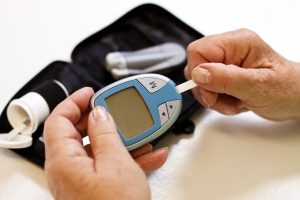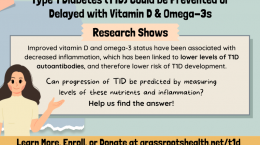Published on August 24, 2023
Often misdiagnosed as Type 2 Diabetes, Type 1.5 or Latent Autoimmune Diabetes in Adults (LADA) has characteristics of Type 1 Diabetes yet it occurs later in life and requires the correct diagnosis for treatment
Key Points
- A subtype of Type 1 Diabetes called Type 1.5 Diabetes (or Latent Autoimmune Diabetes in Adults/LADA) is characterized by the same autoimmune destruction of the cells of the pancreas as seen in T1D, but since it occurs in adulthood, it is often misdiagnosed as Type 2 Diabetes; an estimated 50% of those diagnosed with non-obesity related type 2 diabetes actually have type 1.5 diabetes; overall, an estimated 5-10% of adults diagnosed with type 2 diabetes may have type 1.5
- Indication of an incorrect type 2 diabetes diagnosis could be lower weight than the usual type 2 person or the presence of another autoimmune disease, a family history of T1D or other autoimmune diseases, or earlier need for insulin than most with Type 2 (within a couple of years of diagnosis)
- It is important to get the correct diagnosis in order to get the correct treatment protocol to manage blood glucose and symptoms; a blood test for T1D autoantibodies (Autoimmune Diabetes Panel) is the way to correctly diagnose, as testing positive for one or more indicates type 1 or 1.5
 Type 1 diabetes (T1D) is an autoimmune disorder in which the body’s own immune system attacks and destroys the cells of the pancreas so that they are no longer able to produce insulin. T1D has historically been thought of as a childhood-onset disease, hence referred to as ‘juvenile onset’ diabetes.
Type 1 diabetes (T1D) is an autoimmune disorder in which the body’s own immune system attacks and destroys the cells of the pancreas so that they are no longer able to produce insulin. T1D has historically been thought of as a childhood-onset disease, hence referred to as ‘juvenile onset’ diabetes.
However, a subtype of T1D called Type 1.5 Diabetes (or Latent Autoimmune Diabetes in Adults/LADA), is characterized by the same autoimmune destruction of the cells of the pancreas as seen in T1D, but since it occurs in adulthood, it is often misdiagnosed as Type 2 Diabetes.
Similar to individuals with T1D, those with Type 1.5 Diabetes are also at risk of complications including kidney damage, nerve damage causing pain, tingling, and loss of sensation in the hands and feet, disorders of the eye and vision, and even diabetic ketoacidosis (DKA). Making the correct diagnosis is essential to developing the correct treatment plan for addressing symptoms and preventing disease progression.
The video below discusses the differences between Type 1, Type 2, and Type 1.5 Diabetes, along with symptoms, testing, and other indications that could lead one to question whether their Type 2 Diabetes diagnosis is the correct one for them.
Find out if your body is producing antibodies against your pancreas by adding the Type 1 Diabetes Autoantibodies panel to your custom test kit. (For more valuable information about how to address this health concern, we recommend the Type 1 Diabetes Prevention Test Kit to also measure inflammation and blood sugar levels.)
Test for Type 1 Diabetes Autoantibodies with the T1D Prevention Test Kit Here
Watch Now
Video Summary
Type 1.5 diabetes is a subtype of type 1 diabetes that is frequently misdiagnosed as type 2 diabetes
Note: This 2022 review by Harding et al. demonstrated that the incidence of adult-onset T1D (among those 20 years or older) is substantial and confirms that it is often misdiagnosed as type 2 diabetes.
Type 2 diabetes is extremely prevalent, however, an estimated 50% of those diagnosed with non-obesity related type 2 diabetes actually have type 1.5 diabetes; overall, an estimated 5-10% of adults diagnosed with type 2 diabetes may have type 1.5
What is different about each type of diabetes?
Type 1 = an autoimmune disease that destroys the cells of pancreas, often diagnosed at a younger age, rapid decline in insulin production, rapid onset of symptoms, after diagnosis individuals must rely on exogenous insulin, a lifelong condition
Type 2 = usually occurs later in life (prevalence is increasing in children and teens), body still produces insulin, but that insulin does not function well due to insulin resistance; the condition is not autoimmune and can be reversible in most cases
Type 1.5 = a blend of characteristics of the above; caused by autoimmune attack on cells of pancreas, not by lifestyle choices; the body still produces some insulin, can take steps to control and manage so you don’t have to rely on exogenous insulin; starts at a later age with slower progression compared to type 1
Individuals with type 1.5 also produce autoantibodies against the cells of the pancreas, just as those with type 1 diabetes
Symptoms of type 1.5 include unexplained weight loss, excessive thirst, hunger soon after meals, frequent urination, as well as fatigue, weakness, tingling in hands or feet, dry itchy skin, and blurred vision
Indication of an incorrect type 2 diabetes diagnosis could be lower weight than the usual type 2 person or the presence of another autoimmune disease, a family history of T1D or other autoimmune diseases, or earlier need for insulin than most with T2D (within a couple of years of diagnosis)
Important to get the correct diagnosis in order to get the correct treatment protocol to manage blood glucose and symptoms
Blood test for T1D AABs (Autoimmune Diabetes Panel) is the way to correctly diagnose – testing positive for one or more shows the correct diagnosis of type 1.5; the most common autoantibody is the GAD65 antibody, which may be affected by omega-3 levels
A home blood spot test for the T1D autoantibodies is available through GrassrootsHealth as part of the Type 1 Diabetes Prevention project – order the T1D Prevention Test Kit and participate today, or simply add the T1D Autoantibodies to your custom test kit order to see if you have any of these autoantibodies.
The C-peptide test is also useful to tell you how much insulin your beta cells are still producing (results will be low in type 1, and normal or high in type 2)
Does insulin “always becomes necessary?” Can insulin use be prevented with the prevention study protocol? Learn more here.
Review of meds for type 1.5 to help protect beta cells in pancreas – could vitamin D and omega-3s work as well or better? Help us answer that question!
Studies have shown that getting enough vitamin D can help increase insulin sensitivity
Goals for any type of diabetes – get blood glucose and metabolic health under control; protect beta cells, maximize insulin sensitivity!
Whether discussing the research on type 1 diabetes or type 2 diabetes, evidence has shown that maintaining a vitamin D blood level of 40-60 ng/ml (100-150 nmol/L) and an AA:EPA ratio below 3 may help delay or prevent the development of either, likely due to the roles of vitamin D and omega-3s in managing inflammation and regulating the immune system
Order the T1D Prevention Test Kit Here
Create Your Custom Home Test Kit
 Measure your vitamin D levels at home as part of the D*action project! To know if you are getting enough, make sure you test today!
Measure your vitamin D levels at home as part of the D*action project! To know if you are getting enough, make sure you test today!
You can also measure your:
- Vitamin D
- Magnesium PLUS Essential and Toxic Elements
- Omega-3 Fatty Acids
- hsCRP
- HbA1c
- TSH
- Type 1 Diabetes Autoantibodies
Did you know that each of the above can be measured at home using a simple blood spot test? As part of our ongoing research project, you can order your home blood spot test kit to get your levels, followed by education and steps to take to help you reach your optimal target levels. Start by enrolling and ordering your kit to measure each of the above important markers, and make sure you are getting enough of each to support better mood and wellbeing!
Create your custom home test kit today. Take steps to improve the status of each of these measurements to benefit your overall health. With measurement you can then determine how much is needed and steps to achieve your goals. You can also track your own intakes, symptoms and results to see what works best for YOU.






